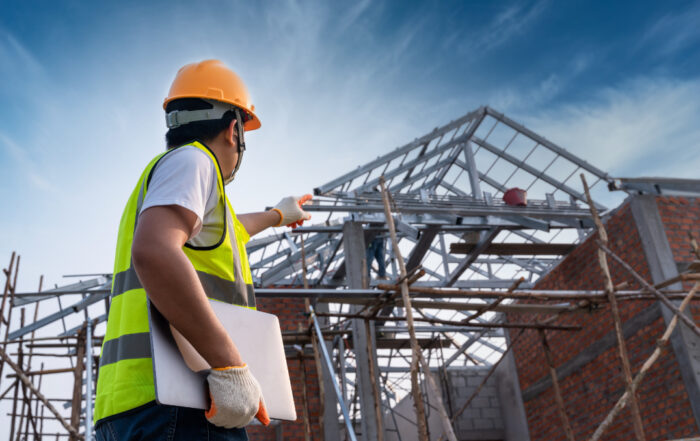The foundation of a building is more than just the base; it’s the bedrock of structural integrity. In the world of construction, a strong and stable foundation is non negotiable. It safeguards against structural deformities and is the key to longevity and safety. This is where foundation inspections come into play, serving as the vigilant gatekeepers of a building’s well being.
The Science Behind Foundations
 Beneath the concrete and steel lies a dynamic world of soil behavior. Understanding soil composition is crucial, as different soil types react differently to the loads placed upon them.
Beneath the concrete and steel lies a dynamic world of soil behavior. Understanding soil composition is crucial, as different soil types react differently to the loads placed upon them.
Different soil types exhibit distinct reactions when subjected to various loads and environmental conditions. Clay soils, for instance, possess the remarkable property of expanding and contracting in response to changes in moisture content. This property can lead to significant challenges in construction.
Soil
When clay rich soils absorb water they grow, and contract when they dry out. These fluctuations in volume can exert pressure on the foundation of a building, potentially causing shifts, cracks, or other forms of damage. Soil science also influences decisions about construction methods.
For instance, engineers might recommend deep foundation systems like piles or piers extending below the problematic soil layers to reach more stable ground in areas with expansive clay soils. In locations with sandy soils, foundations might need to be wider or reinforced with techniques like soil stabilization or geogrids to enhance stability.
Soil and Construction
The interplay between soil behavior and construction must be considered. The stability, durability, and safety of any structure are intimately tied to the properties of the soil upon which it rests. Soil tests and analyses conducted by geotechnical engineers help inform construction professionals about the specific characteristics of the soil at a given site. This knowledge guides decisions about foundation design, materials, and construction methods, ensuring that the structure can withstand the challenges posed by the ever changing and complex world of soil behavior.
Signs of Potential Foundation Issues
Detecting early warning signs can prevent minor issues from snowballing into major problems. Cracks may seem unimportant, but their size, shape, and orientation provide valuable insights into the nature of foundation shifts. A door that suddenly sticks or an uneven floor could signal a deeper issue. Even seemingly unrelated problems like plumbing anomalies might be connected to foundation stress.
Tools of the Trade
 Advancements in technology have armed inspectors with an array of sophisticated tools. Ground penetrating radar (GPR) allows a non-invasive peek beneath the surface, revealing hidden irregularities. Inclinometers measure shifts and tilts, providing data on the magnitude of movement. Water level detectors identify water accumulation risks, a factor often underestimated in its potential for foundation damage.
Advancements in technology have armed inspectors with an array of sophisticated tools. Ground penetrating radar (GPR) allows a non-invasive peek beneath the surface, revealing hidden irregularities. Inclinometers measure shifts and tilts, providing data on the magnitude of movement. Water level detectors identify water accumulation risks, a factor often underestimated in its potential for foundation damage.
When to Bring in the Experts
Routine inspections are akin to health check ups for your building. They’re preventative measures, nipping potential problems in the bud. However, certain indicators shouldn’t be taken lightly. Large cracks, sudden shifts, or visible signs of settling demand immediate attention. Structural engineers bring their expertise, accurately diagnosing issues and prescribing effective solutions.
Steps in a Comprehensive Foundation Inspection
A thorough assessment involves a multi faceted approach. Externally, inspectors scrutinize visible cracks, patterns of settling, and drainage dynamics. Internally, walls and floors are carefully examined for deformities. But it doesn’t stop there. Analyzing the soil and foundation interaction involves tests to determine soil composition and load bearing capacity.
Addressing Discovered Issues
Epoxy injections can often address minor cracks, effectively sealing them and preventing further spread. More severe foundation shifts might necessitate underpinning, reinforcing the foundation’s bearing capacity. Proper drainage solutions can redirect water from the foundation, mitigating erosion risks and water induced damage.
Foundation Maintenance Tips
A holistic approach to foundation care involves strategic landscaping that prevents water accumulation near the building. Consistent vigilance is crucial; a vigilant eye can catch problems while they are manageable. Seasonal changes, especially in harsh climates, demand proactive measures to fortify the foundation against weather induced stress.
A building’s strength ultimately depends on the resilience of its foundation. Regular inspections, understanding soil behavior, and addressing issues promptly are the cornerstones of a secure structure. By prioritizing foundation health, we ensure the safety of occupants and contribute to the longevity of architectural marvels.
New Construction Inspection Services in Northeast Ohio
When it comes to ensuring the longevity and safety of your property’s foundation, trust the experts at Erie Inspection Service. Serving Northeast Ohio, we bring decades of experience and a commitment to excellence in every inspection we conduct.
Contact us on our website, or by calling us at (800) 434-6022 to schedule a comprehensive foundation inspection today. Let us be your partners in building on solid ground and safeguarding your investment for years.




